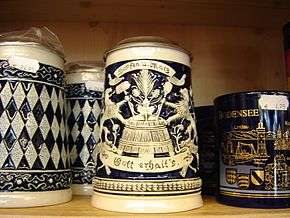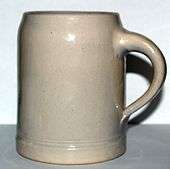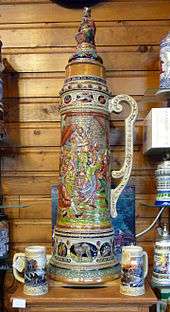Beer stein
Beer stein (/ˈstaɪn/ STYNE), or simply stein, is an English term for either traditional beer mugs made out of stoneware, or specifically ornamental beer mugs that are usually sold as souvenirs or collectibles. In German, the word Stein means stone and is rarely used to refer to a beverage container, with the exception of the state of Rhineland-Palatinate, where it is used for a one litre glass beer mug, similar to the bavarian Maßkrug[1].

Such Steins may be made out of stoneware, pewter, porcelain, or even silver, wood or crystal glass; they may have open tops or hinged pewter lids with a thumb-lever. Steins usually come in sizes of a half litre or a full litre (or comparable historic sizes). Like decorative tankards, they are often decorated in a nostalgic manner, but with allusions to Germany or Bavaria. It is believed by some that the lid was implemented during the age of the Black Plague, to prevent diseased flies from getting into the beer[2].
Etymology

"Stein" may have originated as an abbreviation of German Steinzeug or Steingut[3] (stoneware) or of Steinkrug[4] (stoneware jug), based on the common material for beer mugs before the introduction of glass.
The word Stein alone is not used to refer to a beverage container in German; rather, Krug, Humpen or, especially in southern Germany and Austria, Seidel are used. Likewise the word Bierstein in German suggests calcified residue buildup in a brewing vessel rather than a drinking vessel for beer. Stein was perhaps a familiar sound heard and popularized by American soldiers.
History
It is believed by some that the hinged lid was implemented during the age of the Black Plague, to prevent diseased flies from getting into the beer.[2] While some people do believe this, it is unlikely to be true, as the Black Death is believed to be spread by fleas and contemporaries thought it was spread through dangerous “miasmas,” or poisonous air.
In the latter half of the 19th century, stein makers found different advantages within the different materials. The advantage in using stoneware to make steins was that molds could be used to mass-produce elaborately carved steins. In using glass, not only could one produce multiple glass mugs, but an artistic touch could add to the glass by including acid etchings, glass staining, or even multicolored overlays. Porcelain's advantage was that a stein fabricator could use molds to make "character steins", steins that had a particular shape modeled after an item or a person.[2]
Throughout the 1900s, collecting antique and replicated beer steins became a very popular hobby not only among individual people, but in museums as well. Production of beer steins has become substantial in America, but the largest producer of beer steins is Ceramarte of Brazil.[2]
The most traditional area of beer stein production is the Kannenbäckerland in the Westerwald region in Germany. This unique German potters region has been creating beer steins for centuries and is famous among the collectors as the original German beer stein producer.
On 21 September 2014, Oliver Strumpfel broke the record for most beer steins carried over 40 metres (130 ft) without spilling, managing 25 steins.[5]
Material
Beer steins were made primarily with pewter in many areas across Europe (primarily in England), but many steins were known to be made of glass, porcelain, and silver as well.[6][7] Steins have also been known to have been made out of wood, earthenware, and crystal.[2][6]
Ordinary German beer mugs have been made out of glass for hygienic reasons since the introduction of glass mugs to the 1892 Oktoberfest. Modern beer mugs, except again decorative or luxury versions, do not have a lid.
Beer mugs (0.5 and 1 litre) are typical for beer gardens and especially the Oktoberfest, where they are popular for their robustness. In other settings, 0.33 and 0.5 litre beer glasses are also popular.
Attempts[8] to replace beer mugs made from glass or earthenware by ones made from plastic (for security reasons) have been variously met with protests, even burnings[9] of mugs and were never successful in the long or even medium term in Germany.
The lid
The lids on beer mugs serve as a sanitary measure, especially to keep insects out of the beer[2]. They are usually made out of pewter, and are usually equipped with a lever that is in reach of the thumb, so that it is possible to grab the mug and open and close the lid with a single hand.
These days beer mats are usually used to cover the glass or mug when required.
Other forms and synonyms

In German-speaking regions beer mugs may be known as:
- Bierkrug ("beer mug")
- Maßkrug or Maß (for a one-litre beer mug)
- Humpen
- Adlerhumpen, a tall drinking glass sometimes with covers enamelled with the double eagle of the Holy Roman Empire
- Seidel or Seidla (Franconia, ½ litre). The term Seide is also used by the Pennsylvania Dutch in the Pennsylvania Dutch Country.
- Schoppen (Palatinate, ½ litre)
- Keferloher, the traditional (but non-embellished) stoneware beer mug, named after the village of Keferloh near Munich where they were originally produced
Considered collectible are traditional designs such as brewery emblems, Bavarian motifs such as Neuschwanstein or the Marienplatz Rathaus-Glockenspiel of Munich, and the colorful official annual Oktoberfest souvenir mug featuring the year's winning poster design.
The use of beer mugs is uncommon in most parts of Northern and Central Germany, and in these regions considered a Bavarian specialty.
Pictures
| Wikimedia Commons has media related to Beer steins. |
 Beer stein made in Poland
Beer stein made in Poland A late-19th-century German beer stein
A late-19th-century German beer stein Beer stein commemorating Milwaukee City Hall
Beer stein commemorating Milwaukee City Hall- Beer stein at the Modelo Museum of Science and Industry in Toluca, Mexico
See also
References
- "Biermaße, german Wikipedia".
- Kirsner, Gary (1999). "A Brief History of Beer Steins". Archived from the original on 3 June 2009. Retrieved 19 June 2009.
- "Definition of STEIN". www.merriam-webster.com.
- "Origin and meaning of stein by Online Etymology Dictionary".
- Glenday, Craig. Guinness World Records 2016. 87. ISBN 978-1-910561-01-0.CS1 maint: location (link)
- "German Beer Stein History".
- "Beer Stein History".
- "Empörung in München: Oktoberfest in Plaste". 6 March 2005 – via Spiegel Online.
- Rundfunk, Bayerischer (17 May 2018). "Bergkirchweih Erlangen: Der Berg ruft - BR.de".
External links
- How Beer Steins are produced, a BeerSteinsInternational factory tour on how German Beer Steins are produced
- A Brief History of Beer Steins, an article from a collector's website, taken from The Beer Stein Book: a 400 Year History (ISBN 1-889591-00-9)
- Stein Marks provides a database to determine the provenance of any stein.